1. Ingredients for Beer Production
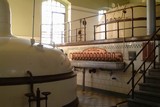 Fresh Water – water used in the beer production must meet the qualitative criteria for fresh water
Fresh Water – water used in the beer production must meet the qualitative criteria for fresh water
Malt – light malt is used for the production of light beer; the production of dark beer uses light malt plus special malts such as coloured malt, caramel malt or Bavarian malt. These malts modify the colour and flavour of dark beer.
Hops Products – are made of hops in order to fully use the most important substances of hops, their steadiness, storability and manipulability
Active Substances – participate in the bitter taste of beer, hops scent, improve flavour steadiness, strongly influence colloidal stability of the product
Division:
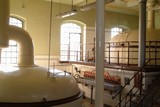 a) Hops granulate = made of hops by mechanic modifications
a) Hops granulate = made of hops by mechanic modifications
b) Hops extract = made by physical modification of hops
Surrogates – imitation of hops. In Czech breweries, sugar and barley starch are mostly used. Optimal amount of surrogates is 10%
2. Wort production Basic brewing terminology:
Hopped Wort – sugery intermediate product appearing in the first stage of the technical beer production process; it contains extractive substances from malt (and surrogates), which are fermentable, and extractive substances from hops products.
Malt Wort (Mash) – contains extractive substances from malt/ surrogates
Original concentration of the hopped wort/beer – concentration of the extract of the original hopped wort
Hopped Wort Production – individual stages
a) Scrapping – i.e. malt milling
b) Pulping
c) Mashing
d) Straining
e) Wort kettle
f) Cooling of the hopped wort through whirpool tank and cooler
Ad b,c) the aim of pupling is to mix the malt grist with water and the aim of mashing is to split and transfer optimal portion of substance extract to the solution. These two processes take place in a mash tun and mash kettle. Mechanic, chemical, physical and enzymatic processes take effect here. The activity of amylolytic, proteolytic and acid-forming enzymes and enzymes splitting cell walls of endosperm is very important here.
Ad d) straining = gaining malt wort (mash) by filtration in lauter tun through the so called draff, which is the rest of malt grist after eduction of extractive substances
Ad e) wort kettle = boiling of the malt wort (mash) with hops products in a kettle, by which we gain the hopped wort
Ad f) whirpool tank serves for separation of the sediments (substances undesirable in beer), which appear in the wort kettle
Brief Production Process:
Stated amount of overground malt and surrogate is mixed with stated amount of water. Through a controlled process of mashing, i.e. warming up to established temperatures which are optimal for functioning of various enzymes from the malt and stated portion of suspended malt grist, the amount of extractive substances is transferred to the solution. Malt starch is splitted by amylases to smaller carbohydrates, which are fermentable. At the same time, the complex of nitrogen substances, mainly proteins, is degraded to various protein fractions, that are represented in a certain portion and they influence the richness of taste, frothing quality, colloidal steadiness of beer and assimilable fractions for nutrition of yeast.
After mashing, the gained solution is overdrawn to the lauter tun, where we gain the malt wort by filtration through a layer of draff. The malt wort is boiled together with hops (wort kettle) and the aim of this process is to transfer technogically important substances from hops to the solution, precipitation of undesirable proteins increasing colloidal steadiness, inactivation of enzymes, gaining of microbe-free hopped wort of desired concentration for a certain type of beer. After proceeding in the wort kettle, hot hopped wort is overdrawn to the whirpool tank, where it is partly cooled down and sediments are extracted. The next step is to cool the hopped wort down by the plate cooler to the fermentation temperature.
3. Main Fermenting – Fermentation Cellar Key words:
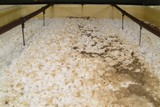 Brewing Yeasts - Sacharomyces cerevisiae subsp.uvarum carlsbergensis – seed yeast of bottom fermentation
Brewing Yeasts - Sacharomyces cerevisiae subsp.uvarum carlsbergensis – seed yeast of bottom fermentation
Fermentation Vessels – vessels in which the process of fermentation is being performed
Main Fermentation – a process, when hopped wort is enriched by seed yeasts that change fermentable sugars to alcohol, carbon dioxide and subsidiary metabolic products
Fermenting Cellar – refrigerated space with fermentation (refrigerated) vessels
Brief Production Process:
Hopped wort - cooled to the fermentation temperature (cca 6°C) in a through-flow cooler - is aerated during the transport to the fementation vessels and it is fermented by seed yeasts. Overall fermentation period is usually 6 to 10 days. During this period, yeasts ferment the major part of the fermentable extract and create alcohol. The temperature during the fermentation is maintained between 8°C and 10°C by cooling the vessels. After termination of the process, yeasts settle.
New beer is created and it is transported to the fermentation cellar, where the process of lagering proceeds. Seed yeasts from the fermentation vessels are washed and reused for a next fermentation.
4. Beer lagering (maturation) – beer – storage cellar Key words:
Lagering – a period of time when beer reaches the best organoleptic qualities; lagering/maturation – saturation with carbon dioxide and clarification of beer
Lager Tanks – closed vessels placed in a refrigerated place, where new beer matures under slight overpressure; the temperature is about 3°C
Lagering – transport of new beer from the fermenting cellar to the beer-storage cellar
Brief Production Process:
 After the termination of the main fermentation, new beer is transported to the beer-storage cellar. This beer still contains a certain portion of unfermented extract, plus it contains a small amount of yeasts. It is barrelled to lager tanks, where the new beer undergoes further lagering. The residual extracts lager in the lager tanks. A little more alcohol is produced, but the main aim of this part of production is natural saturation of beer with carbon dioxide. The time of lagering/ maturation depends on the content of alcohol of beer – ales mature for about 20 – 30 days and lagers for over 40 days.
After the termination of the main fermentation, new beer is transported to the beer-storage cellar. This beer still contains a certain portion of unfermented extract, plus it contains a small amount of yeasts. It is barrelled to lager tanks, where the new beer undergoes further lagering. The residual extracts lager in the lager tanks. A little more alcohol is produced, but the main aim of this part of production is natural saturation of beer with carbon dioxide. The time of lagering/ maturation depends on the content of alcohol of beer – ales mature for about 20 – 30 days and lagers for over 40 days.
Filtration of beer:
The aim of filtration, after the termination of lagering, is extracting sediment substances and residual yeast cells; plus reaching clarity, colloidal steadiness and also biological durability. For beer filtration we use the filters, where the filtration barrier is mostly covered by kieselguhr. It is necessary to avoid contact of the filtered beer with oxygen during the filtration, because during this production stage it has a negative efffect (change of taste, colour, colloidal and microbiologyl steadiness of the end product). To protect the filtered beer from saturation with oxygen we mostly use carbon dioxide, which creates a protective layer; or we can use chemical antioxidants (e.g. ascorbic acid). To increase colloidal steadiness of beer, a range of substances is used based on enzymes (additionally split protein fractions) or based on absorbens, which are added during filtration (absorb protein complexes or polyphenols).
5. Tapping off (Filling Room)
To consumer packages, bottles, KEGs
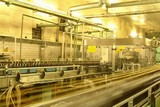 Key Words:
Key Words:
Pasteurization – heat modification of beer in a package or by a flow through pasteurizer to ensure microbiology purity of beer
Taping off is transferring fermented filtered beer of mature taste to transport packaging with minor changes in quality. This means in practice:
a) ensure minimal loss of carbon dioxide ( isobaric tapping off, low temperature)
b) avoid aeration of beer (carbon dioxide or other inert gas, antioxidants)
c) avoid secondary microbiology contamination (sanitation, disinfection, pasteurization)
Brief Production Process:
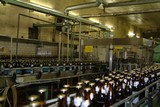 Basic equipment of tapping-off lines are washer of bottles and KEGs, tapping-off machine and equipment for heat modification of beer – through-flow or tunel pasteurizers. In case of using the tunel pasteurizer, beer is tapped off to a washed package, the package is closed and the product is pasteurized. In case of through-flow pasteurizer use, washed packages are filled with already pasteurized beer and consequently the package is closed.
Basic equipment of tapping-off lines are washer of bottles and KEGs, tapping-off machine and equipment for heat modification of beer – through-flow or tunel pasteurizers. In case of using the tunel pasteurizer, beer is tapped off to a washed package, the package is closed and the product is pasteurized. In case of through-flow pasteurizer use, washed packages are filled with already pasteurized beer and consequently the package is closed.
Conclusion:
Beer is a light alcoholic beverage made of barley malt, fresh water and hops products by activity of beer yeasts. After drawing, it creates a compact beer froth, it is characteristic by its bitter taste caused by bitter substances from hops.
According to the concentration of hopped wort extract, we produce draughts (earlier 8%, 10%), lagers (11%, 12%), and special beers (e.g. low-alcoholic). Beer is generally accepted both as a drink for quenching thirst and for its nutritional value. Literature states that drinking a liter of beer a day efficiently helps covering guideline daily amounts of trace elements and minerals.
Sustained hygiene, sanitation and control of in-going ingredients are vital in all parts of the production process.

